


JAMES BRUCE 1730 -
xxxxxThe Scottish explorer James Bruce became interested in North Africa after being appointed British consul at Algiers in 1763. After visiting Roman sites in the Mediterranean area and Syria, he left Cairo in 1768 to discover the source of the Nile. Travelling via the Red Sea he rediscovered the source of the Blue Nile at Lake Tana, and then in 1772 became the first European to follow the course of this river to its confluence with the White Nile at Khartoum. Suffering many hardships during a journey of over 3,700 miles, he eventually returned to London in 1774, where the account of his expedition was disbelieved by many, including the writer Samuel Johnson. In 1790 he published his five-
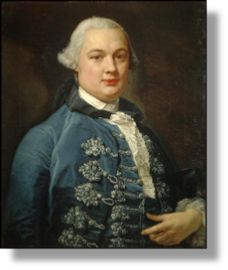 xxxxxIn 1772 the Scottish explorer James Bruce, having rediscovered the source of the Blue Nile two years earlier, became the first European to trace the course of this river to its confluence with the White Nile at Khartoum. Suffering much hardship en route, but convinced that he had found the main source of the Nile, he then continued his return journey, reaching Cairo the following year.
xxxxxIn 1772 the Scottish explorer James Bruce, having rediscovered the source of the Blue Nile two years earlier, became the first European to trace the course of this river to its confluence with the White Nile at Khartoum. Suffering much hardship en route, but convinced that he had found the main source of the Nile, he then continued his return journey, reaching Cairo the following year.
xxxxxBruce was born in Stirling County, Scotland. After a brief career in business, he was appointed British consul in Algiers in 1763, and it was then that his interest in North African history and geography began. He commenced his travels two years later, visiting Rhodes, Cyprus and Syria to study Roman sites. He reached Alexandria in July 1768, and then travelled on to Cairo, determined to make an attempt at discovering the source of the Nile. Journeying south along the river and across the desert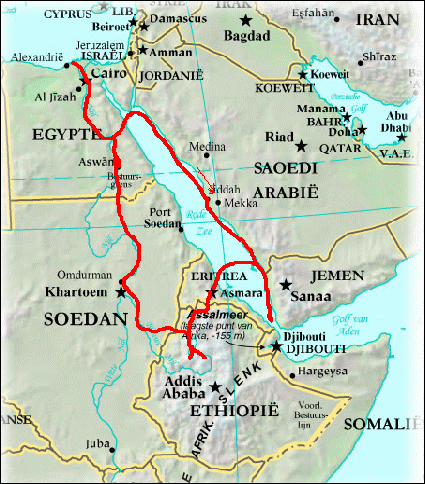 , he then sailed on the Red Sea to the port of Mitsiwa. From there he reached Gondar, the capital of Ethiopia, in February 1770 -
, he then sailed on the Red Sea to the port of Mitsiwa. From there he reached Gondar, the capital of Ethiopia, in February 1770 -
xxxxxHe eventually reached London in 1774, where the report of his journey, covering some 3,700 miles, was received with a large measure of incredulity. We are told that the writer Samuel Johnson was amongst the staunchest of the doubters. Disillusioned but undeterred, in 1780 he began writing a graphic account of his travels. This was published ten years later in his five-
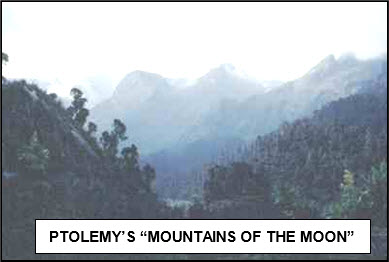 xxxxxThe actual source of the Nile had intrigued men from the earliest of times. The Roman governor of Egypt, Aelius Gallus, for example, had explored the river as far as the first cataract in 25 BC. A further attempt was made in 66 AD, during the reign of the emperor Nero, but had to be abandoned because of the Sudd, a vast swampy region of southern Sudan. The Greek astronomer and geographer Ptolemy, writing in Alexandria in 150 AD, claimed (mistakenly) that the White Nile -
xxxxxThe actual source of the Nile had intrigued men from the earliest of times. The Roman governor of Egypt, Aelius Gallus, for example, had explored the river as far as the first cataract in 25 BC. A further attempt was made in 66 AD, during the reign of the emperor Nero, but had to be abandoned because of the Sudd, a vast swampy region of southern Sudan. The Greek astronomer and geographer Ptolemy, writing in Alexandria in 150 AD, claimed (mistakenly) that the White Nile -
xxxxxIncidentally, the drawings of Roman antiquities which Bruce made during his study of Roman sites, produced with the aid of a camera obscura, can be seen in the royal library at Windsor Castle.
Acknowledgements
Bruce: by the Italian painter Pompeo Girolamo Batoni (1708-
G3a-
Including:
Carsten Niebuhr

xxxxxThe German map-
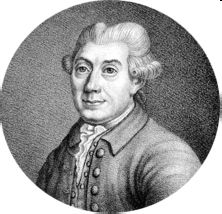 xxxxxWorthy of note during this period was the Danish expedition to Arabia. Among its five members was the German map-
xxxxxWorthy of note during this period was the Danish expedition to Arabia. Among its five members was the German map-
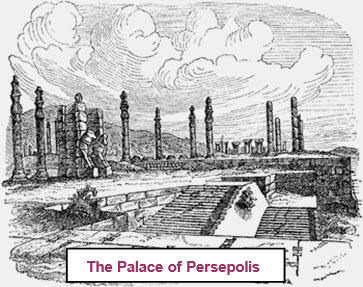
xxxxxHe eventually reached Copenhagen in November 1767 and began compiling an account of his journey, much of it across unexplored terrain as far as Europeans were concerned. This was published in two books, Description of Arabia, produced in 1772, and Travels Through Arabia, two years later. Among his findings were three new cuneiform inscriptions, discovered in the ruins of Persepolis, the ancient capital of Iran. Rightly concluding that they were transcripts of the same text, used by the Persian kings to make their decrees known to three subject nations, he published them in 1777.
xxxxxIncidentally, his son, Barthold Georg Niebuhr (1776-


